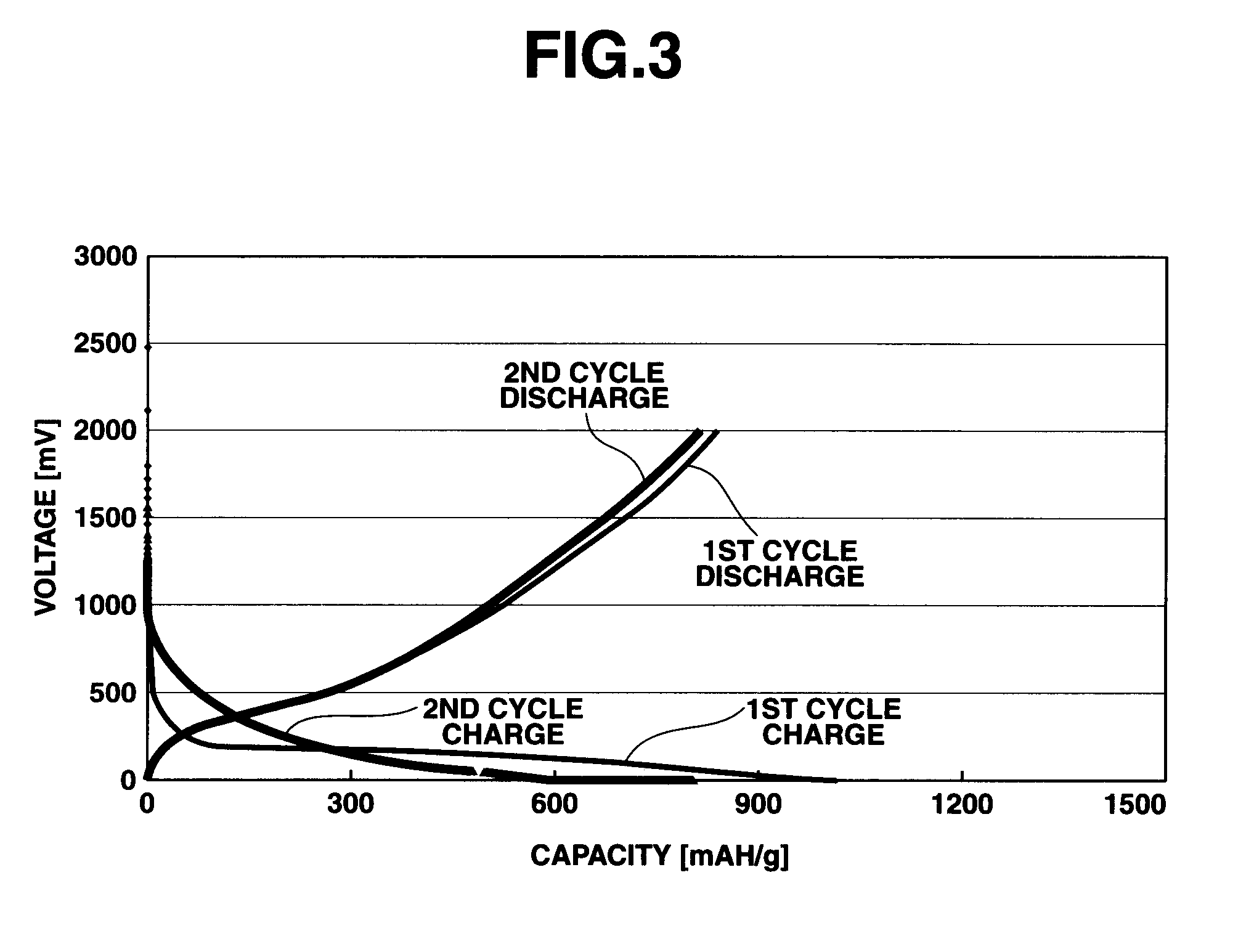SiCO-Li COMPOSITE, MAKING METHOD, AND NON-AQUEOUS ELECTROLYTE SECONDARY CELL NEGATIVE ELECTRODE MATERIAL
- Summary
- Abstract
- Description
- Claims
- Application Information
AI Technical Summary
Benefits of technology
Problems solved by technology
Method used
Image
Examples
example 1
[0092]To a curable siloxane mixture of 120 grams (g) of tetramethyltetravinylcyclotetrasiloxane (LS-8670, Shin-Etsu Chemical Co., Ltd.) and 80 grams (g) of methylhydrogensiloxane (KF-99, Shin-Etsu Chemical Co., Ltd.) was added 0.1 g of a chloroplatinic acid catalyst (1% chloroplatinic acid solution). The mixture was thoroughly mixed and precured at 60° C. for one day. The precured mixture in mass form was placed in a glass container and further in an atmosphere-controllable, temperature-programmable muffle furnace where it was heated in a nitrogen atmosphere at 200° C. for 2 hours until it was fully cured. The cured product was crushed and then milled in a ball mill, using hexane as a dispersing medium, to an average particle size of 10 μm. Then the powder was placed in a lidded alumina container and fired in an atmosphere-controllable, temperature-programmable muffle furnace in a nitrogen atmosphere at 1,000° C. for 3 hours. After cooling, the fired product was pulverized on a grin...
example 2
[0099]A silicone powder X-52-1621 (Shin-Etsu Chemical Co., Ltd.) which is a spherical, trifunctional, highly crosslinked methylsiloxane polymer of the general formula: (CH3SiO3 / 2)n and has an average particle size of about 10 μm was placed in a lidded alumina container. The container was placed in an atmosphere-controllable, temperature-programmable muffle furnace where the powder was fired in a nitrogen atmosphere at 1,000° C. for 3 hours. After cooling, the fired product was pulverized on a grinder (Masscolloider) with a set clearance of 20 μm, yielding Si—C—O composite powder having an average particle size of about 10 μm.
[0100]In a globe box under an argon blanket, a portion (17.0 g) of the Si—C—O composite powder was weighed and placed in a glass vial with an internal volume of about 50 ml. Stabilized lithium powder SLMP (FMC Corp.), 3.0 g, was added to the vial, which was closed with a cap and manually shaken for mixing. The mixture was transferred to a 500-ml stainless steel ...
example 3
[0103]To 50 g of naturally occurring flake graphite having an average particle size of 6 μm was added a curable siloxane mixture consisting of 120 g of tetramethyltetravinylcyclotetrasiloxane (LS-8670, Shin-Etsu Chemical Co., Ltd.), 80 g of methylhydrogensiloxane (KF-99, Shin-Etsu Chemical Co., Ltd.) and 0.5 g of a chloroplatinic acid catalyst (1% chloroplatinic acid solution). Further 100 ml of hexane was added. The mixture in patty form was thoroughly mixed and then heated at 60° C. for removing the solvent and precuring. It was cured in air at 200° C. for one hour.
[0104]The cured mixture in mass form was crushed and then milled in a ball mill, using hexane as a dispersing medium, to an average particle size of 15 μm. After removal of the solvent, the powder was placed in a lidded alumina container and fired in an atmosphere-controllable, temperature-programmable muffle furnace in a nitrogen atmosphere at 1,000° C. for 3 hours. After cooling, the fired product was pulverized on a ...
PUM
 Login to View More
Login to View More Abstract
Description
Claims
Application Information
 Login to View More
Login to View More - R&D
- Intellectual Property
- Life Sciences
- Materials
- Tech Scout
- Unparalleled Data Quality
- Higher Quality Content
- 60% Fewer Hallucinations
Browse by: Latest US Patents, China's latest patents, Technical Efficacy Thesaurus, Application Domain, Technology Topic, Popular Technical Reports.
© 2025 PatSnap. All rights reserved.Legal|Privacy policy|Modern Slavery Act Transparency Statement|Sitemap|About US| Contact US: help@patsnap.com



